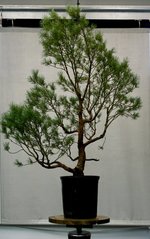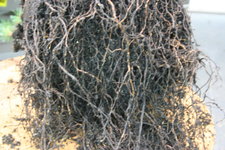River's Edge
Masterpiece
I thought I would share a fundamental bias I have for approaching bonsai development. Whenever I acquire a new tree from a nursery , from collection, or from another bonsai enthusiast the first priority is to determine the condition of the roots and the substrate. Of course, I time the repot in accordance with the species and condition of the tree, time of year and or aftercare available. Thought I would share an example for those that might be interested. This is a Scotch Pine, acquired by a friend from a local nursery and picked up by me for a fun project on development. When I purchased the tree it was evident that the health was reasonable and I thought it had some potential for Bonsai. Beyond that, it was in a five gallon nursery container with what appeared to be compacted dark potting soil. No nebari were visible at the surface or could be seen by scratching below the surface. Although the trunk base had some flare and promise of thicker roots below. The tree was heavy to lift for its size and I suspected very congested roots in the round pot. Current size is 4 inch base and 40 inches tall with healthy but not compact foliage. Not sure of the exact strain but not grafted.
Here is what I found and why it was important to look. 1. better roots than expected. 2. lots of larger rocks 3'-4" in the pot. Take up space? add weight? Save soil? 3. Lots of black soft roots that needed to be removed. ( rotted from excess moisture?)
4. compacted anaerobic conditions primarily in the bottom portion. ( space between rocks filled with muck) 5. fairly compact root ball core that enabled me to secure the tree with bamboo inserted and tied into the Anderson flat. 6. was able to safely reduce height of root ball to less than 5 inches from 12 inches for development. 7. exposed some flair and thicker roots to develop nebari, removed thinner roots higher up out of place for nebari. Plan forward is to use 1/2 HBR in successive repots to further change out the soil and develop a finer root ball that is approximately three inches deep for future bonsai pot placement in a few years. A complete repot for conifer accomplished in three steps over 1 1/2 years approximately. #1 now ( with greenhouse after care) , #2 in fall 2021 and #3 in the spring 2022. The pictures are in the order the work was done.
In this and most cases, the sooner one begins proper development of a Bonsai suitable root ball, the sooner it will be able to thrive in a bonsai pot!










Here is what I found and why it was important to look. 1. better roots than expected. 2. lots of larger rocks 3'-4" in the pot. Take up space? add weight? Save soil? 3. Lots of black soft roots that needed to be removed. ( rotted from excess moisture?)
4. compacted anaerobic conditions primarily in the bottom portion. ( space between rocks filled with muck) 5. fairly compact root ball core that enabled me to secure the tree with bamboo inserted and tied into the Anderson flat. 6. was able to safely reduce height of root ball to less than 5 inches from 12 inches for development. 7. exposed some flair and thicker roots to develop nebari, removed thinner roots higher up out of place for nebari. Plan forward is to use 1/2 HBR in successive repots to further change out the soil and develop a finer root ball that is approximately three inches deep for future bonsai pot placement in a few years. A complete repot for conifer accomplished in three steps over 1 1/2 years approximately. #1 now ( with greenhouse after care) , #2 in fall 2021 and #3 in the spring 2022. The pictures are in the order the work was done.
In this and most cases, the sooner one begins proper development of a Bonsai suitable root ball, the sooner it will be able to thrive in a bonsai pot!










